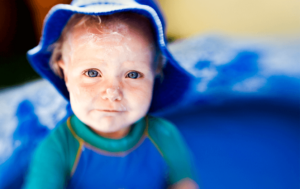Heat rash mostly happens in hot, humid weather. Anyone can get heat rash, but it is most common in infants and young children.
The Risk for Heat Rash in Children
Babies on the move are bound to sweat. It means there is a chance of them having this condition, especially during summertime. Children 3 to 36 months old tend to have higher body temperature than most adults. Add the occasional crawling, running, and exploring their surroundings makes their temperature climb higher.
Heat rash occurs after exposure to extreme heat if a child sweats too much. According to a pediatrician Paula Sabella, MD. “Excessive sweating can cause a child’s pores (sweat gland ducts) to be blocked, and perspiration can become trapped underneath the skin.”
It can result in irritation, red, and itchy skin, known as heat rash.
What is Heat Rash
Heat rash, also known as miliaria or prickly heat, is a skin irritation that stings and causes skin redness. After exposure, small bumps may form along with the “prickly” tingling pain. It is likely to appear in areas where skin touches the skin. These include the neck, groin, and creases of elbows and armpits.
Skin rash cases are not life-threatening. Ease the symptoms with first aid treatment at home.
Treatment for Heat Rash
Rashes usually start clearing up as soon as the baby gets to cool off. Here are several treatments to begin healing the skin rash.
- Cool the skin
Cold compresses help cool and soothe the skin after sun exposure. Wrap an ice pack in a clean towel and apply it to the skin.
Start removing extra layers of clothing and move the child into an ideal indoor space. Apply cool compresses and dry the skin thoroughly afterwards.
- Apply water
For minor rashes – Gently dab a cool, wet cloth on the affected area to relieve tenderness and bring down skin temperature.
For more significant rash – Give the child a cool bath for at least 10 minutes. Avoid using soap and other chemicals as they can further irritate the skin. Let the skin dry afterwards.
- Try steroid creams
Broken blisters from heat rash can lead to a skin infection. If the inflammation becomes too itchy and bothersome, apply over the counter (OTC) ointments with 1% hydrocortisone cream onto the bumpy area.
Steroid creams are known to have side effects. Be sure to discuss with a doctor before use.
- Use calamine lotion
Severe cases of heat rash will require the use of calamine lotion to stop any itching. Apply it on the affected area to help cool the skin.
With treatment, rashes will clear up within 2 to 3 days.
How to Avoid Heat Rash
The best way to deal with sun rashes is to avoid getting one. It may take extra effort, but it will be worth it when none of the children is dealing with an itchy rash.
- Dress in loose and lightweight clothing
- Spend more time as possible in air-conditioned places
- Use non-drying soaps
- Let the skin air-dry instead of towelling off
- Use sunscreen to prevent sunburns
- Take a break and make sure that a child does not overheat while outside at the beach or playground (signs of overheating include flushed cheeks, shallow breathing, and rapid pulse)
- Hydrate by drinking plenty of cool water.
Sun rashes are a non-medical emergency. But if left untreated, it can lead to further complications. Seek professional help for rashes that lasts for more than three days with at-home treatments. Check if the rash starts showing signs of infection or if the symptoms become worse.
Conclusion
Prickly heat appearing on the skin is the body’s way of telling you to cool down and get out of the heat. Make sure to stay hydrated in warm weather and while doing physical activity.
Learn first aid to recognize signs of overheating and other heat-related illnesses.

